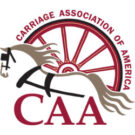
What is the AIAT?
The ambition and objective of the AIAT (Association International d’Attelage de Tradition) is to promote and encourage the use of traditional carriages plus the skills and traditions of driving those carriages in a competent and pleasurable manner. The AIAT was founded in 2008 by Baron Christian de Langlade, who is the President of the Association. The spirit of the AIAT is based on friendship, camaraderie, and the free sharing of knowledge.
The Carriage Association of America is the representative organization of the AIAT in the United States. The CAA governs the use of the terms Concours d’Attelage de Tradition™, Concours Internationale d’Attelage de Tradition™ within the United States as the official representative organization for the United States of the AIAT.
To run a Concours Internationale d’Attelage de Tradition™(CIAT) in the United States a request must be made to the CAA. A CIAT event must, without exception, be run in accordance with AIAT rules in their entirety, using AIAT licensed international or national judges, and the use of the names and or terms CIAT, Attelage, Concours d’Attelage de Tradition™, Routier, Maniabilité, etc. or other trademarks or wordmarks of the AIAT must be approved by the CAA as the representative organization of the AIAT in the United States.
A Sporting Day of Traditional Driving under house rules may still be held without prior approval of the CAA.
A CIAT event (Concours Internationale d’Attelage de Tradition™) consists of three phases – Presentation, The Routier™ (a road drive), and Maniabilité™ (cones driving) and encompasses other enjoyable social activities in a friendly, relaxed, and sporting style. The event is held at beautiful country locations with over 60 events in 14 countries annually.
Attelage de Tradition Event Guidelines
CIAT™ (International) and CAT™ (National) events are run in three phases according to a set of guidelines which can be found below.
CAT™ (National) events may have fewer Performance Challenges along the Routier, or no Routier and be performed in one day.
AIAT Guidelines 2024 (Download)
Forms for Organizers
The AIAT-USA Committee has put together some helpful forms for Event Organizers. They can be accessed below.
Phase I: Presentation
During the Presentation phase, entries are provided time slots in which to appear before the competition judges. The entries are inspected by each individual judge, and are scored during this phase on the overall impression, the condition of the horse, the fit and appropriateness of the harness & carriage, passengers, and attire. The scores are weighted in favor of traditional antique carriages (those constructed before 1945), but modern carriages are permitted. The Presentation scores are recorded on an AIAT score sheet, which in the educational spirit of the AIAT is provided to competitors after the competition is finished.

Phase II: Road Drive (Routier) & Performance Challenges (PCs)
The Routier (Road Drive) portion of a CIAT event includes up to 5 Performance Challenges, the format of which can be chosen by the organizer from a list of 16 PCs as sanctioned by the AIAT.
AIAT Performance Challenges 2024 (Download)

Phase III: Cones (Maniabilité)
The Maniabilité (cones driving) is the final phase of a CIAT event. This phase is to test the skill of the driver and the obedience and agility of the horses on a given course. The course should be free flowing, with a maximum of 20 gates.
Organizing a CIAT Event in the United States
For more information on organizing an CIAT event in the United States, contact the CAA at info@caaonline.com.
The Carriage Association of America is the representative organization in the United States for the AIAT.
Official Office of the AIAT:
Association Internationale d’Attelage de Tradition
Baron Christian de Langlade, President
95, Avenue Victor Hugo,
F-75116 Paris
France
www.aiatinternational.com
Note: The terms Concours International d’Attelage de Tradition™, Concours d’Attelage de Tradition™, Routier™, and Maniabilité™, are wordmarks of the Association International d’Attelage de Tradition and may not be used without express permission.
No portion of the AIAT Guidelines, Performance Challenges, or forms generated by the AIAT or the CAA AIAT Committee may be copied or used in the United States without express permission of the CAA.

You must be logged in to post a comment.